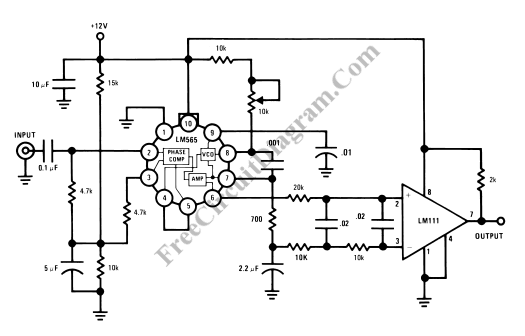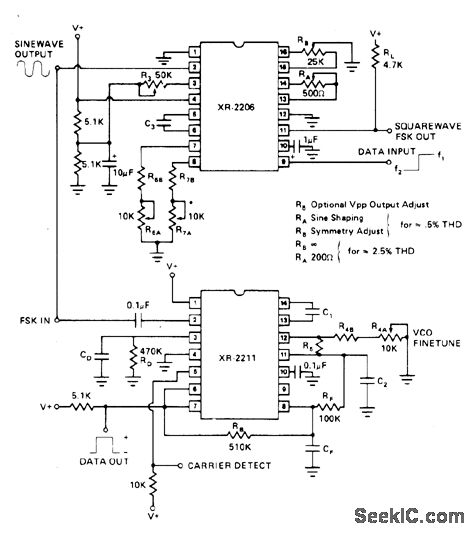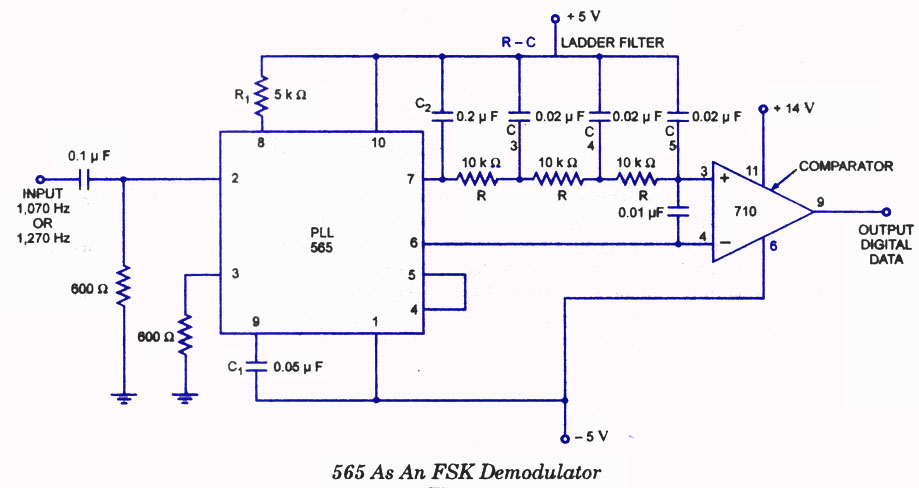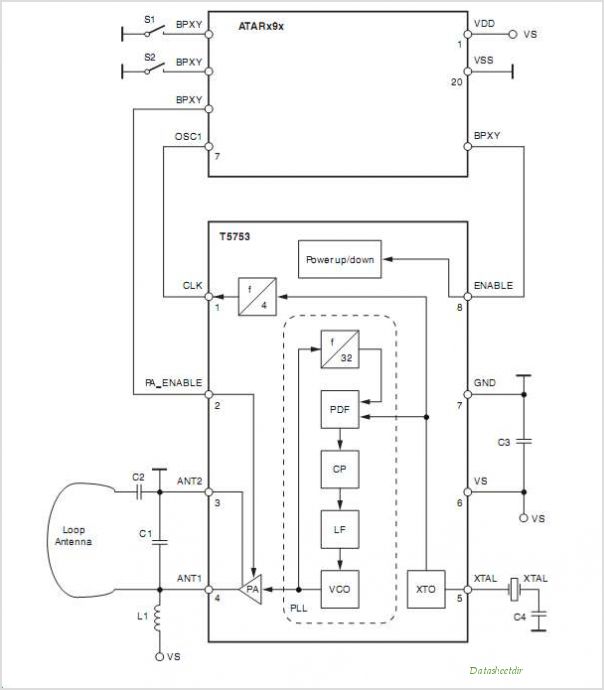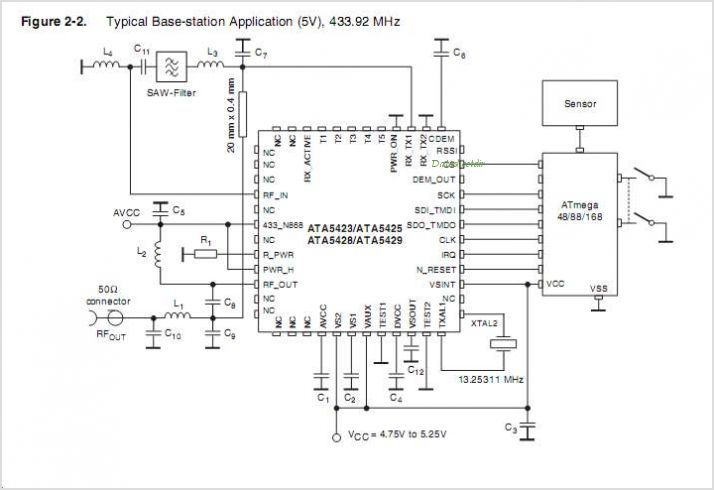
The Mainline TT/L FSK Demodulator
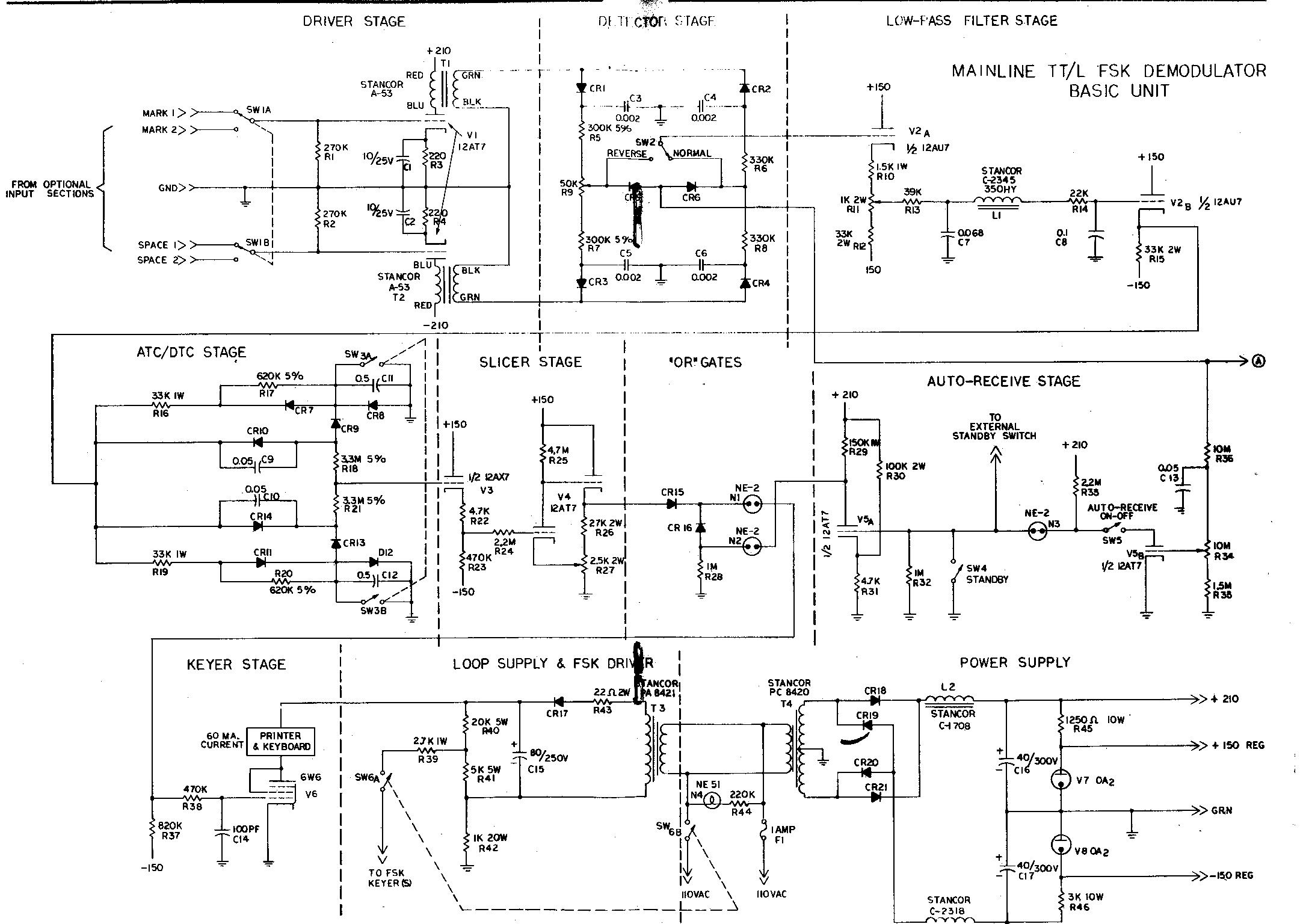
The term "demodulator" is becoming a standard in both commercial and military sectors. "Converters" are often associated with devices that automatically transform Morse code into RTTY, convert 8-level signals to 5-level, or adjust baud rates from 50 to 45, among other functions. This project originated from dissatisfaction with traditional limiterless techniques (including the TU-E, which K8DKC referred to as the TU-H after minor modifications) and the intention to integrate concepts proposed by Beard and Wheeldon, Thomas, the DTC circuit, Poor, and others. It was soon recognized that the demodulator must accommodate both FM and AM detection. Consequently, the TT/L FSK Demodulator represents a high level of versatility, featuring a "basic unit" to which various input types (FM, two-tone, narrow shift, etc.) can be easily and affordably added. This also serves as an excellent "test bed" for further development, allowing comparative tests to be conducted with the same unit and establishing a clear trend. When the basic FM with limiter section is included, the complete unit is designated as the TT/L version. If an additional limiterless input section is incorporated, it becomes the TT/LF. In cases where a heterodyne unit is added, enabling variable shift with narrow filters, it is referred to as the TT/LH. At K8DKC, all three sections have been combined (TT/LFH). The limiter section can operate in a limiterless mode, providing three two-tone input configurations ranging from broadband to 70-eps Collins filters. At W8SDZ, the basic TT/L is operational and has demonstrated excellent results (for both FM and broadband limiterless operation) that currently do not necessitate the addition of further input sections. After completing this project, tests were conducted at K8DKC on these various input units using an audio tape recorder. Generally, it can be stated that, except for nearby CW QRM where the 70 cps filters showed distinct advantages, the limiterless configuration has provided minimal benefits compared to the FM system. In fact, the FM system has frequently exhibited superior performance, particularly when communicating with weak European stations and under static conditions. The FM section was tested with a receiver featuring a 2.1 filter and no band-pass input filter, placing it at a disadvantage, especially considering that tones of 1275/2125 were employed on a linear discriminator. Results thus far suggest that, aside from testing and occasional CW interference, the alternate limiterless systems would rarely be utilized. Further experimentation is planned, and it is advisable to construct and test the basic unit with the FM section. The FM section can be quickly converted to two-tone by activating the limiter bypass switch, facilitating prompt and economical adaptation to any desired input type. Additionally, an auxiliary FM unit can be developed for any alternate shift or interchangeable plug-in discriminator filters could be employed. This design, created by Vic Poor, K3NIO, is a 3-pole Butterworth type filter with a bandwidth of slightly over 1 kHz. It utilizes 88-mH toroids, and appropriate capacitance values are achieved by paralleling several common values. This is a two-stage transformer-coupled system characterized by zero-time constant properties for optimal noise burst and impulse noise protection. It provides approximately 50,000 times gain and limits down to -56 dB input. The normal input range is 2-5 volts RMS at 500 ohms for optimal performance. Cascaded 6BN6 tubes are utilized, which clip impulse noises instantaneously and symmetrically. It is advisable to avoid RC coupling between stages of a good limiter, as this introduces an undesired time constant. A switch is included to bypass the limiter for two-tone broad-filter applications.
The TT/L FSK Demodulator is designed to provide a flexible and adaptable solution for signal demodulation in various operational contexts. Its modular architecture allows for the integration of different input types, making it suitable for a wide range of applications, including amateur radio and professional communication systems. The ability to switch between FM and AM detection enhances its usability, catering to diverse signal formats encountered in real-world scenarios.
The implementation of a 3-pole Butterworth filter is particularly noteworthy, as it ensures that the demodulator maintains high fidelity while rejecting unwanted noise and interference. The choice of toroidal inductors and the careful selection of capacitance values contribute to the overall performance, enabling the system to achieve significant amplification without compromising signal integrity.
Furthermore, the cascading of 6BN6 tubes within the limiter section is a critical design choice, facilitating rapid response to impulse noise while preserving the quality of the desired signal. This configuration is essential for applications where signal clarity is paramount, such as in weak signal conditions or environments with significant electromagnetic interference.
Overall, the TT/L FSK Demodulator stands out as a sophisticated and versatile device, capable of meeting the demands of both casual and professional users in the field of signal processing and communication. Its design reflects a comprehensive understanding of the challenges associated with demodulation and a commitment to providing a reliable solution that can adapt to evolving technological needs.The word "demodulator" is becoming standard practice with commercial and military organizations. "Converters" are now often thought of with respect to units automatically changing Morse code to RTTY; changing 8-level to 5-level; changing 50 Baud to 45 Baud, etc. This project grew out of dissatisfaction with conventional limiterless methods (even t he TU-E which K8DKC called the TU-H after minor modifications) and the desire to incorporate the concepts outlined by Beard and Wheeldon, Thomas, the DTC circuit, Poor, and others. It was soon discovered that the demodulator would need provisions for both FM and AM detection. As a result, the TT/L FSK Demodulator is perhaps the ultimate in versatility since it has a "basic unit" to which any type of input (FM, two-tone, narrow shift, etc.
) may easily and inexpensively be added. This offers, at the same time, an excellent "test bed" for further development work if comparative tests are to be made, they can then be made with the same unit, and a definite trend established. If the basic FM with limiter section is added, the total unit is then called the TT/L version. If a limiterless input section is further added, it becomes the TT/LF. If, as a few might do, a heterodyne unit is added allowing variable shift with narrow filters, this is called the TT/LH.
At K8DKC, all three sections have been added (TT/LFH). The limiter section can be operated limiter-less; giving three two-tone input configurations possible from broadband to 70-eps Collins filters. At W8SDZ, the basic TT/L is in use, and has been giving such excellent results (both on FM and with the limiter switched out for broad-band limiter-less operation) that no plans at present call for additional input sections to be added.
Since completing this project, tests have been run at K8DKC on these various input units, utilizing an audio tape recorder. In general, it can be said that with the exception of nearby CW QRM when the 70 cps filters showed definite advantages, the limiter-less so far has offered little advantage over the FM system.
On the contrary, the FM system has quite often displayed better copy than the limiter-less. This includes talking with weak European stations; static conditions; and in general, any conditions so far encountered. The FM section was being used with a receiver having a 2. 1 filter and no band-pass input filter. The would place the FM section at its greatest disadvantage when one further considers that tones of 1275/2125 were being used on a linear discriminator.
Results so far indicate that if it were not for testing and occasional CW interference, the alternate limiter-less systems would be seldom used. Further experimentation is planned. We would therefore suggest that the basic unit with FM section be built and tried. (The FM section converts immediately to two-tone with operation of the limiter bypass switch. ) This method allows quick and inexpensive adaptation to any type of input desired. It also allows an auxiliary FM unit to be constructed for any alternate shift desired; or interchangeable plug-in discriminator filters could be used.
This was designed by Vic Poor, K3NIO, specifically for this demodulator. It is a 3-pole Butterworth type of slightly over 1 kc. In width. It uses 88-mh. toroids, and proper capacitance values are made by paralleling several of the common values. This is a 2-stage transformer-coupled system of zero-time constant characteristics for maximum protection against noise bursts, impulse noises, etc. It has about 50, 000 times gain and limits down to -56 dB. input. Normal input is 2-5 volts RMS at 500 ohms for optimum operation. It utilizes cascaded 6BN6 tubes which clip impulse noises instantaneously and symmetrically. One does not want to use RC coupling between stages of a good limiter, as this inserts an undesired time constant.
A switch has been provided to by-pass the limiter for two-tone broad-filte 🔗 External reference
The TT/L FSK Demodulator is designed to provide a flexible and adaptable solution for signal demodulation in various operational contexts. Its modular architecture allows for the integration of different input types, making it suitable for a wide range of applications, including amateur radio and professional communication systems. The ability to switch between FM and AM detection enhances its usability, catering to diverse signal formats encountered in real-world scenarios.
The implementation of a 3-pole Butterworth filter is particularly noteworthy, as it ensures that the demodulator maintains high fidelity while rejecting unwanted noise and interference. The choice of toroidal inductors and the careful selection of capacitance values contribute to the overall performance, enabling the system to achieve significant amplification without compromising signal integrity.
Furthermore, the cascading of 6BN6 tubes within the limiter section is a critical design choice, facilitating rapid response to impulse noise while preserving the quality of the desired signal. This configuration is essential for applications where signal clarity is paramount, such as in weak signal conditions or environments with significant electromagnetic interference.
Overall, the TT/L FSK Demodulator stands out as a sophisticated and versatile device, capable of meeting the demands of both casual and professional users in the field of signal processing and communication. Its design reflects a comprehensive understanding of the challenges associated with demodulation and a commitment to providing a reliable solution that can adapt to evolving technological needs.The word "demodulator" is becoming standard practice with commercial and military organizations. "Converters" are now often thought of with respect to units automatically changing Morse code to RTTY; changing 8-level to 5-level; changing 50 Baud to 45 Baud, etc. This project grew out of dissatisfaction with conventional limiterless methods (even t he TU-E which K8DKC called the TU-H after minor modifications) and the desire to incorporate the concepts outlined by Beard and Wheeldon, Thomas, the DTC circuit, Poor, and others. It was soon discovered that the demodulator would need provisions for both FM and AM detection. As a result, the TT/L FSK Demodulator is perhaps the ultimate in versatility since it has a "basic unit" to which any type of input (FM, two-tone, narrow shift, etc.
) may easily and inexpensively be added. This offers, at the same time, an excellent "test bed" for further development work if comparative tests are to be made, they can then be made with the same unit, and a definite trend established. If the basic FM with limiter section is added, the total unit is then called the TT/L version. If a limiterless input section is further added, it becomes the TT/LF. If, as a few might do, a heterodyne unit is added allowing variable shift with narrow filters, this is called the TT/LH.
At K8DKC, all three sections have been added (TT/LFH). The limiter section can be operated limiter-less; giving three two-tone input configurations possible from broadband to 70-eps Collins filters. At W8SDZ, the basic TT/L is in use, and has been giving such excellent results (both on FM and with the limiter switched out for broad-band limiter-less operation) that no plans at present call for additional input sections to be added.
Since completing this project, tests have been run at K8DKC on these various input units, utilizing an audio tape recorder. In general, it can be said that with the exception of nearby CW QRM when the 70 cps filters showed definite advantages, the limiter-less so far has offered little advantage over the FM system.
On the contrary, the FM system has quite often displayed better copy than the limiter-less. This includes talking with weak European stations; static conditions; and in general, any conditions so far encountered. The FM section was being used with a receiver having a 2. 1 filter and no band-pass input filter. The would place the FM section at its greatest disadvantage when one further considers that tones of 1275/2125 were being used on a linear discriminator.
Results so far indicate that if it were not for testing and occasional CW interference, the alternate limiter-less systems would be seldom used. Further experimentation is planned. We would therefore suggest that the basic unit with FM section be built and tried. (The FM section converts immediately to two-tone with operation of the limiter bypass switch. ) This method allows quick and inexpensive adaptation to any type of input desired. It also allows an auxiliary FM unit to be constructed for any alternate shift desired; or interchangeable plug-in discriminator filters could be used.
This was designed by Vic Poor, K3NIO, specifically for this demodulator. It is a 3-pole Butterworth type of slightly over 1 kc. In width. It uses 88-mh. toroids, and proper capacitance values are made by paralleling several of the common values. This is a 2-stage transformer-coupled system of zero-time constant characteristics for maximum protection against noise bursts, impulse noises, etc. It has about 50, 000 times gain and limits down to -56 dB. input. Normal input is 2-5 volts RMS at 500 ohms for optimum operation. It utilizes cascaded 6BN6 tubes which clip impulse noises instantaneously and symmetrically. One does not want to use RC coupling between stages of a good limiter, as this inserts an undesired time constant.
A switch has been provided to by-pass the limiter for two-tone broad-filte 🔗 External reference
